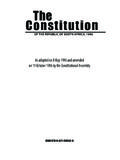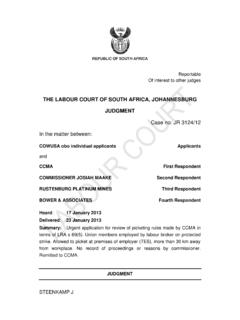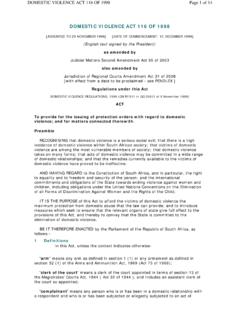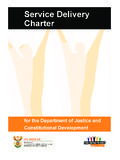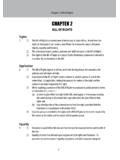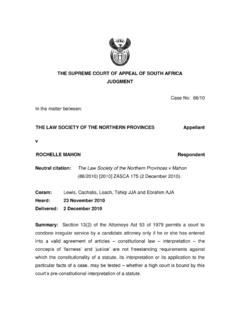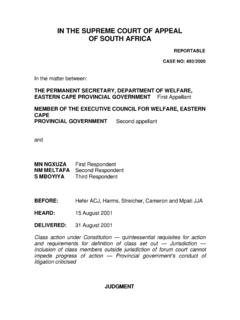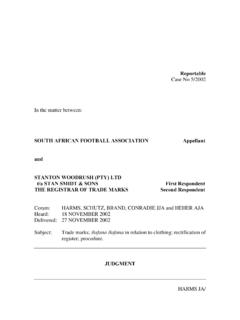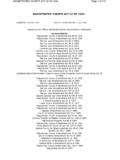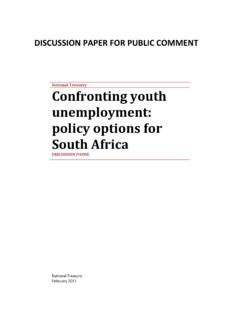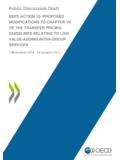Transcription of SOUTH AFRICAN LAW REFORM COMMISSION …
1 SOUTH AFRICAN LAW REFORM COMMISSION discussion paper 0001/2009 Project 107 SEXUAL OFFENCES ADULT PROSTITUTION Closing date for comment: 30 June 2009 ISBN: 978-0-621-38498-7 (ii) INTRODUCTION The SOUTH AFRICAN Law REFORM COMMISSION was established by the SOUTH AFRICAN Law REFORM COMMISSION Act, 1973 (Act 19 of 1973). The members of the COMMISSION are Madam Justice Y Mokgoro (Chairperson) Mr Justice WL Seriti (Vice-Chairperson) Professor C Albertyn Mr Justice DM Davis Ms T Madonsela (Full-time member) Mr T Ngcukaitobi Advocate DB Ntsebeza (SC) Professor PJ Schwikkard Advocate M Sello The Secretary is Mr M Palumbo. The COMMISSION 's offices are on the 12th floor, Sanlam Centre, corner of Andries and Schoeman Streets, Pretoria. Correspondence should be addressed to: The Secretary SOUTH AFRICAN Law REFORM COMMISSION Private Bag X668 PRETORIA 0001 Telephone : (012) 392-9540 Fax : (012) 320-0936 E-mail : ; Website : The project leaders for the investigation are Ms T Madonsela and Professor C Albertyn.
2 The researchers responsible for the investigation, who may be contacted for assistance, are Mrs D Clark and Mrs C Pienaar. (iii) PREFACE This discussion paper has been prepared to elicit responses from interested parties and to serve as a basis for the COMMISSION 's deliberations. Following an evaluation of the responses and any final deliberations on the matter, the COMMISSION may issue a report on this subject which will be submitted to the Minister of Justice and Constitutional Development for tabling in Parliament. The views, conclusions and recommendations in this paper are not to be regarded as the COMMISSION 's final views. The paper is published in full so as to provide persons and bodies wishing to comment or to make suggestions for the REFORM of this particular branch of the law with sufficient background information to enable them to place focussed submissions before the COMMISSION .
3 The COMMISSION will assume that respondents agree to the COMMISSION quoting from or referring to comments and attributing comments to respondents unless representations are marked confidential. Respondents should be aware that under section 32 of the Constitution of the Republic of SOUTH Africa, 1996 (Act No. 108 of 1996) the COMMISSION may have to release information contained in representations. Respondents are requested to submit written comments , representations or requests to the COMMISSION by 30th June 2009 at the address appearing on the previous page. Any requests for information and administrative enquiries should be addressed to the Secretary of the COMMISSION or the researchers assigned to this project, Mrs D Clark and Mrs C Pienaar. (iv) TABLE OF CONTENTS Page Introduction (ii) Preface (iii) Table of contents (iv) Summary of the discussion paper on adult prostitution (x) Sources with mode of citation (xvii) Table of cases (xlvi) Selected legislation (xlvii) International conventions, declarations and protocols, AFRICAN instruments, other international documents (xlix) PART I CHAPTER 1: BACKGROUND TO, AND PROGRESS OF, THE INVESTIGATION Introduction 1 Background and scope 2 Methodology 4 Public participation in the investigation 5 Terminology 6 Outline of discussion paper 7 PART II THE LEGAL AND POLICY CONTEXT OF PROSTITUTION CHAPTER 2.
4 INTRODUCTION AND BACKGROUND Introduction 9 Defining prostitution 9 Society's response to prostitution and different legal models 10 Existing legal position in SOUTH Africa 14 Impact of the current law 19 Impact of criminalisation on prostitutes 19 Impact in relation to the purpose of the Act 23 (v)Reasons for becoming a prostitute 26 Socio-economic determinants 27 The demand for prostitution 34 Alternatives to prostitution? 36 Prevalence and the face of prostitution in SOUTH Africa 40 Indoor prostitution in SOUTH Africa 42 Independent 'self employed' prostitutes 42 Independent contractors 43 Agencies 43 Other indoor venues 44 Advertising 44 Working conditions applying to prostitutes in the indoor sector 45 General 45 Pricing 45 Employment conditions 46 The fining system 47 Outdoor prostitution in SOUTH Africa 48 Profile of outdoor prostitution 48 Working conditions of prostitutes in the outdoor sector 50 Pricing 50 The role of pimps in outdoor prostitution 51 Client violence 52 Policy
5 Implications 53 CHAPTER 3: PROSTITUTION AND CRIME Introduction 56 The criminogenic nature of prostitution 56 Concerns relating to public nuisance 58 Enforcement 59 Indoor sector 59 Outdoor sector 61 Police harassment 64 The link between prostitution and drugs 66 Prostitution and trafficking 67 Crimes against prostitutes 70 (vi)CHAPTER 4: PROSTITUTION AND HIV/AIDS Introduction 72 Prostitution and the spread of HIV 73 Condom use and safe sex 77 Legal responses to prostitution and HIV 81 Expanded criminal and/or regulatory response 81 Non-criminalisation 82 A human rights approach 83 PART III INTERNATIONAL AND COMPARATIVE LAW ON PROSTITUTION CHAPTER 5.
6 THE INTERNATIONAL HUMAN RIGHTS FRAMEWORK OF THE LAW ON PROSTITUTION Introduction to the international human rights framework of the law on prostitution 87 International instruments 89 AFRICAN instruments 89 Other international documents 90 The Convention for the Suppression of the Traffic in Persons and of the Exploitation of the Prostitution of Others of 1949 90 International Covenant on Civil and Political Rights of 1966 92 International Convention on Economic, Social and Cultural Rights of 1966 93 Convention on the Elimination of All Forms of Discrimination against Women of 1979 94 General Recommendation No 19 - Violence against women 96 General Recommendation No 24 - Women and health 98 Declaration on the Elimination of Violence against Women of 1993 99 Beijing Declaration, Platform for Action 1995 and Reaffirming Resolution of 2005 100 The Protocol to Prevent, Suppress and Punish Trafficking in Persons, especially Women and Children of 2003 100 AFRICAN instruments 101 The AFRICAN Charter on Human and People's Rights of 1986 101 The Protocol to the AFRICAN Charter on Human and People's Rights on the Rights of Women of 2005 102 (vii)
7 Addendum to the 1997 Declaration on Gender and Development by SADC Heads of State or Government of 1998 104 SADC Protocol on Gender and Development of 2008 104 Other international instruments 105 UNAIDS International Guidelines on HIV/AIDS and Human Rights 105 World Charter for Prostitutes' Rights of 1985 106 Summary 107 Conclusion 109 CHAPTER 6: COMPARATIVE STUDY OF THE LAW ON PROSTITUTION IN DIFFERENT JURISDICTIONS Introduction to the comparative study of the law on prostitution in different jurisdictions 110 History of the law on prostitution 110 The context of comparative analysis 112 Prostitution laws in the United States of America 113 Prostitution laws in Sweden 118 Prostitution laws in the Netherlands 125 Prostitution laws in Germany 129 Prostitution laws in Thailand 134 Prostitution laws in the United Kingdom of Great Britain and Northern Ireland 142 Prostitution laws in New Zealand 152 Prostitution laws in AFRICAN
8 Countries 159 Botswana 159 Ghana 160 Kenya 161 Lesotho 161 Namibia 162 Nigeria 163 Swaziland 163 Uganda 163 United Republic of Tanzania 164 Zambia 164 Senegal 165 Cote d Ivoire 166 (viii)The International Labour Organisation 167 The ILO Report 167 comments on the ILO report 169 The European Court of Justice 171 PART IV LEGAL MODELS AND PROPOSALS CHAPTER 7: DIFFERENT LEGAL FRAMEWORKS FOR PROSTITUTION LAW AND PUBLIC RESPONSES Introduction to different legal models for prostitution 172 Total criminalisation 174 Partial criminalisation 174 Non-criminalisation 175 Regulation 175 The total criminalisation and partial criminalisation models 176 Features of the total criminalisation and partial criminalisation options 176 comments by respondents to the Issue paper on the total criminalisation and partial criminalisation model 177 Evaluation of the model to criminalise prostitution (total criminalisation) or certain aspects of prostitution (partial criminalisation)
9 182 The non-criminalisation model 186 Features of the non-criminalisation model 186 comments by respondents to the Issue paper on the non-criminalisation model 187 Evaluation of the model for non-criminalisation of prostitution 192 The regulation model 198 Features of the regulation model 198 Licensing of prostitution businesses 199 Registration of prostitutes 199 Zoning requirements 199 Limiting outdoor prostitution 199 Role of local governments and municipal by-laws 200 comments by respondents to the Issue paper on the regulation model 200 Regulation or not? 201 Licensing of prostitution-businesses 202 (ix)Registration of prostitutes 204 Zoning 207 Mandatory health testing 208 Special conditions to be imposed under regulation 210 Role of local governments and municipal by-laws 210 Evaluation of the model to legalise prostitution 211 Registration of prostitution-businesses 216 Health and hygiene of prostitutes 216 Violence against and exploitation of prostitutes 218 Issues of social stigma 221 Government s interests in regulating prostitution 222 Conclusion 223 CHAPTER 8.
10 PROPOSALS FOR REFORM OF THE LAW ON PROSTITUTION Introduction to proposals for law REFORM 226 Background to the proposals for law REFORM 226 Proposals for law REFORM 228 General proposals 230 Question on general proposals 230 Proposal 1: Total criminalisation of prostitution and prostitution related activities 231 Questions on proposal 1 - Total criminalisation 233 Proposal 2: Partial criminalisation of prostitution and prostitution related activities 234 Questions on proposal 2 - Partial criminalisation 236 Proposal 3: Non-criminalisation of prostitution and prostitution related activities 237 Questions on proposal 3 Non-criminalisation 241 Proposal 4: Regulation of prostitution and prostitution related activities 243 Questions on proposal 4 Regulation 248 ANNEXURE A: CURRENT LEGAL POSITION IN SOUTH AFRICA 250 ANNEXURE B: LIST OF RESPONDENTS TO ISSUE paper 19 275
